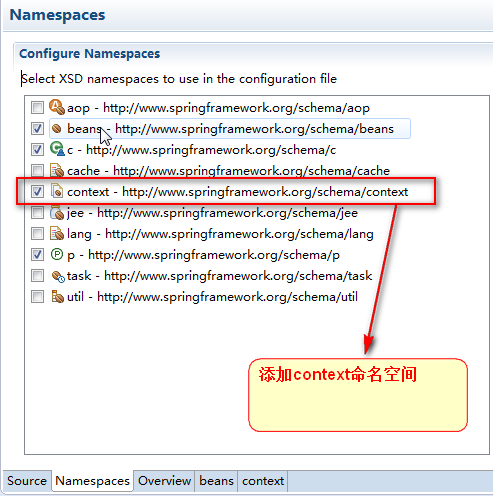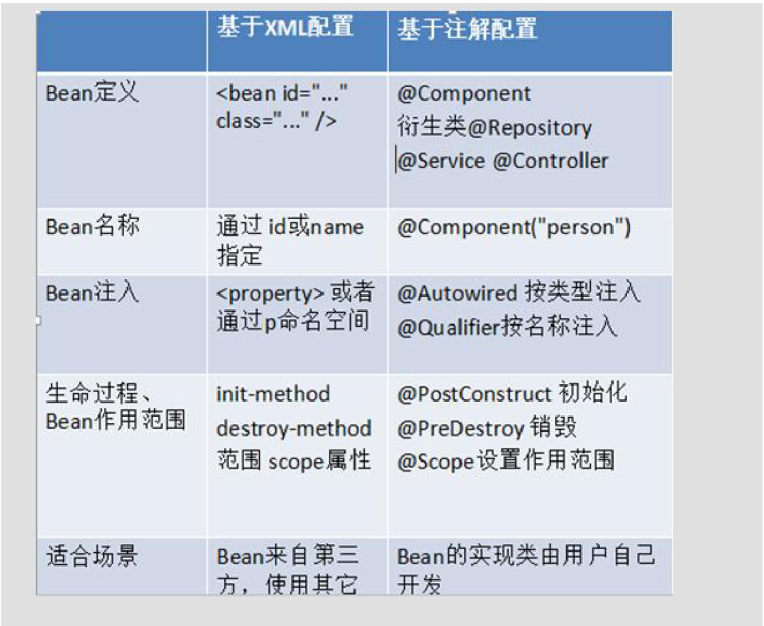spring与web的整合
1. 整合的原理:
Spring容器随着tomcat容器ServletContext的启动而启动,并且在初始化完成后放到整个应用都可以访问的范围。
ApplicationContext随着服务器的启动而启动,可以借助与Servlet/Filter/Listener任何一个;
把创建好的ApplicationContext放到ServletContext中,整个应用范围,想怎访问就怎么访问;
spring-web-4.2.4.RELEASE.jar包中提供了Listener的支持(spring建议的方式)
WebApplicationContextUtils是Spring官方提供的一个web环境下便捷从ServletContext中获取ApplicationContext的工具类。
2. 整合的步骤
● 添加依赖
<!-- https://mvnrepository.com/artifact/org.springframework/spring-web --> <dependency> <groupId>org.springframework</groupId> <artifactId>spring-web</artifactId> <version>4.2.4.RELEASE</version> </dependency> <!-- https://mvnrepository.com/artifact/javax.servlet/javax.servlet-api --> <dependency> <groupId>javax.servlet</groupId> <artifactId>javax.servlet-api</artifactId> <version>3.1.0</version> <scope>provided</scope> </dependency>
● 配置监听器,监听web项目的启动
<!-- needed for ContextLoaderListener --> <context-param> <param-name>contextConfigLocation</param-name> <param-value>classpath:applicationContext.xml</param-value> </context-param> <!-- Bootstraps the root web application context before servlet initialization --> <listener> <listener-class>org.springframework.web.context.ContextLoaderListener</listener-class> </listener>
● 创建servlet,在servlet中获取spring容器
1 public class ContextServlet extends HttpServlet { 2 private static final long serialVersionUID = 1L; 3 4 protected void doGet(HttpServletRequest request, HttpServletResponse response) throws ServletException, IOException { 5 // 1. 获取spring容器 6 // 获取servletContext域对象 7 ServletContext servletContext = getServletContext(); 8 // web环境的spring容器 9 WebApplicationContext applicationContext = WebApplicationContextUtils.getWebApplicationContext(servletContext); 10 // 2. 从容器中获取javabean对象 11 Person person = (Person) applicationContext.getBean("person4"); 12 System.out.println(person.getUsername()); 13 response.getWriter().append("Served at: ").append(request.getContextPath()); 14 } 15 16 protected void doPost(HttpServletRequest request, HttpServletResponse response) throws ServletException, IOException { 17 doGet(request, response); 18 } 19 }
● 访问servlet进行测试
浏览器访问:http://localhost:8080/ContextServlet
spring容器基于注解方式的开发
● 优缺点:
缺点:
1、如果所有的内容都配置在.xml文件中,那么.xml文件将会十分庞大;如果按需求分开.xml文件,那么.xml文件又会非常多。总之这将导致配置文件的可读性与可维护性变得很低。
2、在开发中在.java文件和.xml文件之间不断切换,是一件麻烦的事,同时这种思维上的不连贯也会降低开发的效率。
优点:
Spring基于注解方式的开发,通过"@XXX"的方式,让注解与Java Bean紧密结合,既大大减少了配置文件的体积,又增加了Java Bean的可读性与内聚性。
● 开发步骤:
导入依赖
<!-- https://mvnrepository.com/artifact/org.springframework/spring-aop --> <dependency> <groupId>org.springframework</groupId> <artifactId>spring-aop</artifactId> <version>4.2.4.RELEASE</version> </dependency>
添加context命名空间的schema

开启注解扫描context:component-scan
<!-- 开启spring的注解扫描 --> <!-- 扫描包下带注释的类及类中带注释的属性 --> <context:component-scan base-package="spring.annotation.demo"></context:component-scan>
添加注解
Spring中和注入相关的常见注解有Autowired、Resource、Qualifier、Service、Controller、Repository、Component。
- Autowired是自动按照类型注入,自动从spring的上下文找到合适的bean来注入
- Resource用来指定名称注入
- Qualifier和Autowired配合使用,指定bean的名称
- Service,Controller,Repository分别标记类是Service层类,Controller层类,数据存储层的类,spring扫描注解配置时,会标记这些类要生成bean。
- Component是一种泛指,标记类是组件,spring扫描注解配置时,会标记这些类要生成bean。
上面的Autowired和Resource是用来修饰字段,并做属性注入的。而Service,Controller,Repository,Component则是用来修饰类,标记这些类要生成bean。
1 @Repository 2 public class CarDao { 3 public void insertCar(){ 4 System.out.println("CarDao中的insertCar的方法被调用... ..."); 5 } 6 }
1 @Service 2 //@Component 3 @Scope(value="singleton") 4 public class CarService { 5 // 自动按照类型注入,自动从spring上下文中找到合适的bean来注入 6 @Autowired 7 private CarDao carDao; 8 9 public void insertCar(){ 10 carDao.insertCar(); 11 System.out.println("CarService中的insertCar方法"); 12 } 13 14 @PostConstruct 15 public void init(){ 16 System.out.println("init方法被调用... ..."); 17 } 18 19 @PreDestroy 20 public void destory(){ 21 System.out.println("destory方法被调用... ..."); 22 } 23 }
编写测试代码
1 public static void main(String[] args) { 2 ClassPathXmlApplicationContext applicationContext = new ClassPathXmlApplicationContext("applicationContext-annotation.xml"); 3 CarService bean = (CarService) applicationContext.getBean("carService"); 4 bean.insertCar(); 5 }
@Autowired + @Qualifier 结合使用:指定注入bean的名称
@Resouce注解:@Resource注解实现的效果和@Autowired+@Qualifier的效果是一样的
@Scope用于指定scope作用域的(用在类上)
@PostConstruct用于指定初始化方法(用在方法上)
@PreDestory用于指定销毁方法(用在方法上)
@Value 可以为我们的基本数据类型以及string进行属性赋值
xml配置方式与注解方式的对比

spring与Junit整合测试
整合后测试的优点
整合后测试变得非常简单
避免频繁、重复的容器加载
整合Junit的步骤
导入spring-test的jar包
<dependency> <groupId>org.springframework</groupId> <artifactId>spring-test</artifactId> <version>4.12</version> <scope>test</scope> </dependency>
编写Junit整合测试类
1 @RunWith(SpringJUnit4ClassRunner.class)//使用Junit4进行测试 2 @ContextConfiguration("classpath:applicationContext-annotation.xml")//加载配置文件 3 public class JunitSpringTest { 4 @Autowired 5 private CarService carService; 6 7 @Autowired 8 private CarDao carDao; 9 10 @Test 11 public void test01(){ 12 carDao.insertCar(); 13 } 14 }